|
<< Turn back a page
|
|
(click picture for enlargement)
|
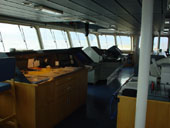 |
A view of the navigation bridge during sailing. On the table to the left is the maritime charts and the ship's log book, in the middle the wheel and radar and to the right in the picture is working space, PC and control panels for various systems onboard the ship. During night hours, only instrument lights are on, giving the bridge a special atmosphere. |
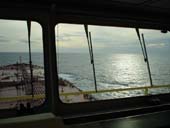 |
A beautiful view from the bridge (wheel house). I like the way the colors of the ocean and the sky switch when comparing one side of the picture with the other. At this point we're doing around 15 knots, which is normal in loaded condition. |
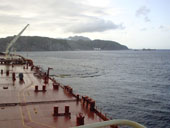 |
After more than 30 days at sea, we reached Saint Eustatius in the Carribean Ocean. We berthed at a bouy one mile from the coast. Two thick hoses connected us with large tanks on shore (visible on top of the mountain), and the ship's own pumps disharged a total of 300,000 tons of crude oil. The discharge took little more than a day. |
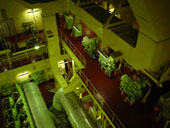 |
Here we're having a look in the engine room, the main engine visible in the bottom left corner of the picture. The engine room is more than 10 stories high. Note the doors in the upper left corner and the one two decks below that one. Sailing in warm waters, temperatures easily reach 40 degrees Celcius in the engine room. |
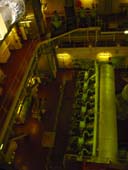 |
Standing in front of the boilers and looking down at the main engine. Three extra valve housings can be seen in the top of the picture, one with a cylinder cover attached. The vertical metallic shaft to the left is the elevator shaft. |
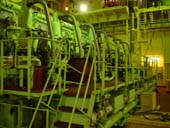 |
The main engine, capable of producing 35,000 horse power at full load and weighing over 800 metric tons. This 2-stroke, crosshead, diesel engine is of SULZER make, and has 7 cylinders with a bore of 0.84 meters. |
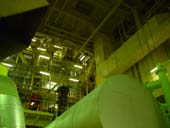 |
In the back ground the two huge boilers, capable of producing 50,000 kilograms of steam an hour each, consuming nearly 4 tons of fuel oil per hour in the process. Tankers have a huge demand for steam during discharging operations, since the cargo pumps are driven by steam turbines. Just in front of the right boiler is a spare cylinder liner for the main engine, and beside that a spare piston. In the top center of the picture the engine room hatch can be seen. |
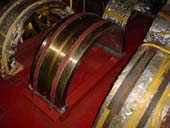 |
These are the spare pans for the crank shaft bearings. The crank shaft rests in one half, and the other half is bolted on top, forming a ring around the crank shaft. This pan is unwrapped because Jens and I had just made a new stand for it (the red thing underneath and the hoops). The pan rests on two peeces of wood wrapped with lead, and the hoops are wrapped in lead too. The pans are about 1 meter in diameter. |
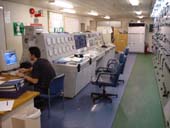 |
Standing in the Engine Control Room, the heart of the Engine Room. From here all machinery can be monitored, along with pressure values, temperatures, tank levels, power consumption and much more. With more measuring points than a NASA Space Shuttle, everything has to be carefully organized. Some modern ships are fitted with an Integrated Control System, ICS, which allows the engineer to monitor and control most of the engine room systems from one computer. Eli Mærsk does not have an ICS. Simon is checking his email in-box. |
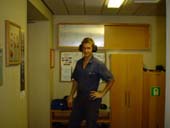 |
Me, waiting for the elevator in the Engine Control Room. The light blue boiler suits with the Maersk logo, as seen on other pictures, are used as a sort of uniform, while these dark boiler suits are used for every-day work. I have just come in from the engine room, which explains the ear protectors. |
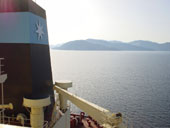 |
Anchored in the bay of Angra Dos Reis, Brazil, about 80 miles south of Rio de Janeiro. Another ship was already berthed at the oil terminal, so we had to wait for three days in the middle of the bay. It was beautiful surroundings and we enjoyed being there. There were lots of boats, everything from large bay liners to small fishing boats. The picture is taken from port side bridge wing looking south. |
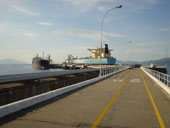 |
Having successfully berthed at the oil terminal, it was a half mile walk to shore along these concrete piers. Half way I turned around to take this picture. The ship on the left discharged their cargo into our tanks and was followed by two more ships until we reached the maximum capacity of 300,000 tons. All 8 cadets including me had lots of time off during the week the loading took, and enjoyed many hours ashore. |
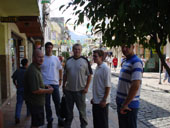 |
A 45 minute bus drive from the oil terminal we reached the small city of Angra dos Reis. We had a good look at the city before finding the bus terminal to head for Rio de Janeiro. We returned to Angra dos Reis several times during our stay, and also enjoyed dinner at local restaurants. Great country! |
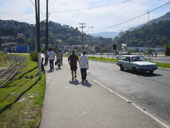 |
Walking along the beach in Angra dos Reis around 10:00 AM temperatures had already reached well over 30 degrees Celcius. At noon it was even warmer, which explains why school is out from around noon to 2:00 PM. We found a turist office where we asked for directions to the bus terminal. |
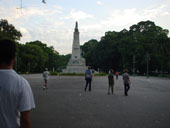 |
A picture from the large park in Rio de Janeiro. The park was fenced and full of homeless cats. It closed around 6:00 PM as it was getting dark. My friend Simon, whom I also sailed with on the "Knud Mærsk", is seen in the left foreground. |
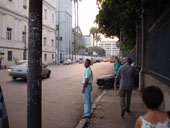 |
Just outside the park I took this picture, impressed with the large palm trees in the back ground. This is a typical street in Rio de Janeiro, but also large financial districts with sky scrapers and hotels are found. |
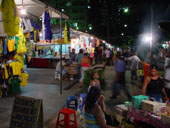 |
Markets like these are a common sight in Rio, and often several families build small cozy "villages" of shops and stores. You can find almost everything from clothes to electrical appliances at these markets. Brazilians love soccer, which explains the shop to the left selling jerseys. |
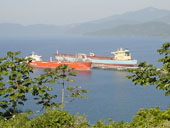 |
The day after our trip to Rio de Janeiro, we went hiking in the mountains around the bay. This picture is taken using zoom. Note that the front ship is another one than on the previous pictures of the pier. This was a Norwegian ship, and we later met some of the crew on a bar just outside the terminal. |
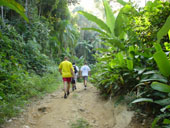 |
Having walked for a while we found ourselves in a real rain forest. There are several houses in the mountains, laying scatted throughout the forest. Some have electricity, even fewer water, making it quite a contrast to the western world I'm used to. It was hot, hazy and very humit at this time of the day just around noon. |
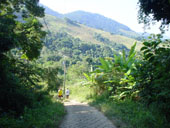 |
Further down the trail we reached some open land. The power and phone lines can be seen in the middle of the picture. |
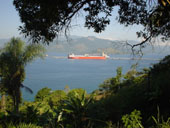 |
Another great view of the bay and our ship (blue one). |
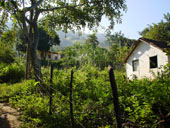 |
Having walked for little more than an hour we reached a small village of about 15 homes. As you can see there are no glass in the windows, but they do have TV sets so it isn't due to a lack of money. Windows just aren't neaded. It was a cozy little village, and the locals were very friendly. |
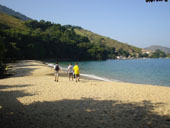 |
A short walk from the village the path ended at this great beach. It was well over 30 degrees Celcius, so we had a swim before going back. The next day we returned to spend several hours on the beach, and had a great day. |
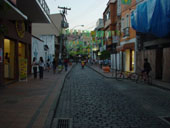 |
Along with fellow cadet Simon I went for another trip to Angra Dos Reis for supplies to the ship's store. We brought back loads of chocolate, candy, soft drinks and snacks, and had a lot of fun in town. We met a local who spoke English and he helped us find some of the stuff. This picture is taken around 6:00 PM, but not until now were school children on their way home. |
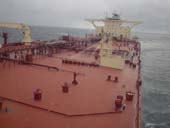 |
Having departed from Brazil we headed for India. Reaching Cape of Good Hope in South Africa, I signed off along with the other cadets and several other crew members and went home for vacation. We left the ship by helicopter in quite bad weather, which was an exiting experience. I shot these pictures out the window of the helicopter. |
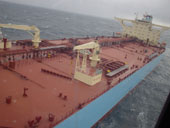 |
Another view of the deck as seen from the helicopter. The tank hatches closest to the side of the ship leed to the ballast tanks, while the ones further towards the middle lead to cargo tanks. The deck houses are used for storage. |
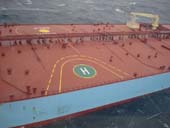 |
A nice view of the deck layout, with some of the crew members who assisted in the helicopter operation. |
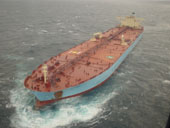 |
A great view of the ship seen from the helicopter. The "Eli Mærsk" was actually making way through the water as we left it, doing about 2 knots. This was to make it easier for the helicopter to land on deck. |
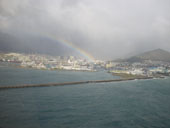 |
After 20 minutes of flying Cape Town appeared ahead of us. The weather was better here than off the coast, but it was still raining. The perfect condition for a beautiful rainbow like this one. |
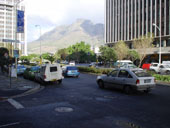 |
The streets of Cape Town. The city is actually surrounded by mountains, among these the famous Table Mountain. Unfortunately we didn't have time to go there, which would have been great. We had about 24 hours in Cape Town, spending one night at a hotel. That gave us a perfect chance for checking out the night life, and aproaching the evening we went out for dinner and then visited a local bar. We had lots of fun, and found time to chat with the local youth, who speak good English. |
| << Turn back a page |